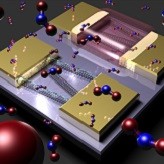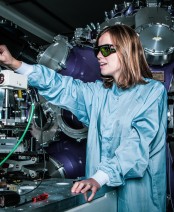A miniature gas sensor based on carbon nanotubes

 Image Credits : Salomé Forel
Image Credits : Salomé Forel
"There's Plenty of Room at the Bottom": In a founding speech for nanotechnology, physicist Richard Feynman encouraged researchers to explore the "world" of the infinitely small. Sixty years later, the discoveries continue and the applications are multiplying. The exploration of “the bottom” has led to the discovery and synthesis of new nanometric materials (one nanometer = one billionth of a meter = one hundred thousandth of a hair's thickness).
The research team of Costel-Sorin Cojocaru, CNRS research director at the Laboratory of Physics of Interfaces and Thin Films (LPICM*) is particularly interested in carbon nanotubes and their use in sensors. Thanks to funding from the André Citroën Chair, they have developed an electronic device for the detection of nitrogen dioxide (NO2) present in the atmosphere at extremely low concentrations (below ppm). Their work is published in the scientific journal Nanoscale Advances.
Carbon nanotubes
Single-walled carbon nanotubes (SWCNTs) are one of the emblematic materials of nanotechnologies that have been revealing their incredible mechanical, optical and electronic properties since their discovery 30 years ago.
They are extremely sensitive to their environment: the presence of molecules nearby can induce a measurable change in some of their properties. This sensitivity makes them excellent candidates for use in sensors.
Sensors to measure pollution
To combat air pollution, it must first of all be measurable. The development of sensors for toxic and/or polluting gases is therefore of crucial importance.
The use of carbon nanotubes in these sensors is particularly coveted because it would allow the miniaturization of the devices.
When nanotubes are used as conductivity channels in a field-effect transistor (an electronic component that acts as a switch for the current), their sensitivity to the presence of certain molecules induces a modification of the response of the transistor, allowing their detection.
However, the currents measured in this type of device are very low, and require the use of amplifiers and a measurement chain that goes against the potential miniaturization of the devices, and which considerably increases their energy consumption.
Towards more efficient sensors
It is to meet these environmental challenges that Costel-Sorin Cojocaru team (Salomé Forel, Leandro Sacco, Alice Castan and Ileana Florea), expert in carbon nanotubes, from their synthesis to their integration in sensors, has conducted a study published on the cover of Nanoscale Advances. Based on a patent and two previous studies financed mainly by the André Citroën Chair, they used single-wall carbon nanotubes in an electronic device for the detection of nitrogen dioxide (NO2) present in the atmosphere at concentrations below ppm.
The innovation of this work lies in the coupling of two nanotube-based transistors to form an inverter, or logic gate. In this configuration, the detection of gas molecules is done by measuring the modulation of the output voltage of this inverter - of the order of magnitude of one volt - not requiring the complex and energy-consuming measurement chain mentioned above.
This device is also potentially very versatile, because carbon nanotubes can be made sensitive to various molecules by functionalization, i.e. by fixing on the nanotubes other molecules that make them specifically sensitive to other gas.
> Learn more : read the publication
*LPICM: a joint research unit CNRS, École Polytechnique - Institut Polytechnique de Paris








